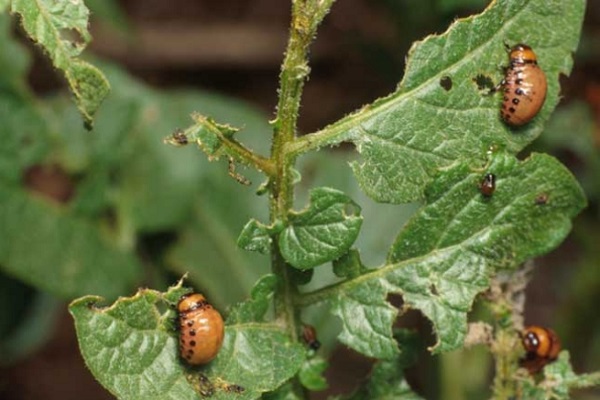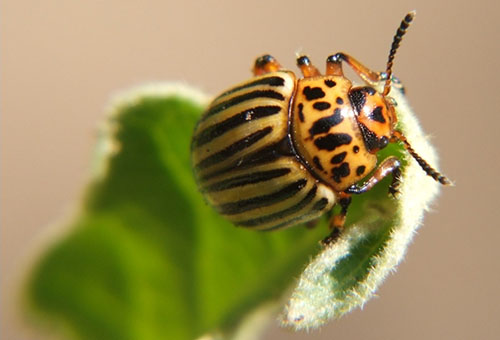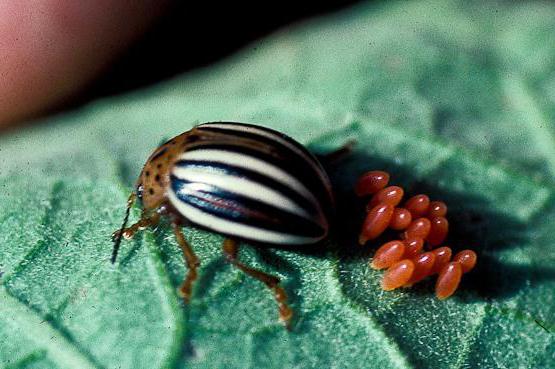How to get rid of the Colorado potato beetle folk remedies
Content
Description of the pest
To fight this pest, you need to know at least minimal information about it. The Colorado potato beetle came to us from North America. It was first seen in Colorado, which is where its name actually came from. Today, this pest is ubiquitous and destroys nightshade crops around the globe.
It is especially dangerous for planting the following plants:
- potato. Beetles prefer it to all other cultivated plants;
- eggplant;
- pepper;
- tomatoes.
The Colorado potato beetle differs from other insects in black stripes on a round yellow-orange black shell. It is this color that allows you to quickly identify pests on plantings.
It hibernates in the ground, burrowing into it to a depth of 10-30 cm. It enters from wintering when the soil warms up to 14-15 ° C. Females are able to lay about 20-30 eggs on one leaf (the lower part of the leaf plate). The egg stage lasts approximately 18 days. The larva hatched from the egg becomes an adult at 18-24 days. The first young beetles appear in late June or early July. Moreover, only a part of the population participates in the reproduction process. The second one buries in the ground for wintering, entering diapause.
Plants are harmed by both adult beetles and larvae. Insects eat young stems and leaves. As a result of damage to more than 50% of the leaf surface, the yield decreases to 65-70%. At the same time, there is a decrease in the commercial quality of the crop. It is easy to identify the Colorado potato beetle, just look at the planting up close, especially looking under the leaves.
Folk recipes
Many gardeners do not want to use pesticides for the fight, which can accumulate in the fruits. Therefore, most experienced gardeners prefer to fight insects with folk remedies.
You can quickly and effectively get rid of this pest in several ways:
- tinctures;
- natural helpers.
In order to figure out which type of fight against the Colorado potato beetle is more beneficial, we will consider both methods in more detail.
Tinctures
Many professional gardeners use various tinctures to get rid of this pest. Insect control in this situation involves spraying the plantings with prepared solutions. It is noted that it is the infusions that have the most destructive effect on Colorado.
Using this method of struggle, it must be remembered that the key to success here is strict adherence to the instructions in the process of preparing the solution.
Of the popular infusions used by gardeners to combat this leaf gnaw, the following can be distinguished:
- infusion of walnuts. One kg of leaves (you can add green fruits to them) must be poured with boiling water and let the solution brew with the lid closed for about a week. After that, the infusion should be filtered. You can also pour boiling water over 300 g of nutshells with the same 10 liters of boiling water and leave for a week. After the solution, you also need to strain;
- white acacia remedy.Here it is necessary to pour 10 liters of water into the crushed and dried bark of a tree (1 kg). The tincture costs 3 days, after which it is filtered;
- poplar solution. Half a bucket of poplar leaves is poured with boiling water. It is kept for 15 minutes, and then the volume is brought to 10 liters. This infusion should be kept for 3 days.
Sunflower can also be used to combat leaf gnawing. For 10 liters of water, you need to add 0.5 kg of flowers and stand for 3 days. Onion peel has proven itself well in this situation. Here you should take 300 g of raw materials and fill it with hot water. The solution under the load should be infused for a day.
Somewhat less often, in order to get rid of Colorado beetles, gardeners use horsetail and dandelion. To prepare a solution of 10 liters of water, 200 g of horsetail and 200 g of dandelion are poured. The resulting infusion should be boiled for 15 minutes. You can spray the plants immediately after the solution has cooled.
After the infusions are completely ready, you can spray your plantings with them. To achieve a more stable and high-quality effect, the solution can be used several times with a short period of time.
Video "Remedy for the Colorado potato beetle"
Natural helpers against beetles
Another successful way to get rid of leaf gnaws is to use their natural enemies. But here you will need to try a little to teach such helpers to eat larvae and beetles. In this matter, the use of poultry is more relevant to combat the pest. They are easier to use than wild birds or insects.
It is worth remembering that not all birds can eat these insects, since these beetles will be poisonous for them. This is due to the fact that the leaves of potatoes contain solanine, which accumulates in the bodies of insects, making them quite poisonous and specific in gastronomic terms. As a result, you will not only not rid your garden of leaf gnawing, but also harm the birds themselves.
The following types of poultry will help you get rid of these pests:
- homemade chicken;
- guinea fowl;
- pheasant;
- turkey.
Birds are taught to such a "special" diet from childhood, adding little by little crushed bugs to the feed. From wild birds, starlings can peck at leaf-beetles. Among insects, the natural enemies for Colorado are lacewing, ladybugs and ground beetles. If everything is done correctly, then assistants will be able to bring tangible benefits in the fight against the Colorado potato beetle.
Useful Tips
In addition to the above methods of struggle, for the preservation of the beds of potatoes and other nightshade crops, a number of useful tips have been developed that will help you cope with this scourge. These include the following points:
- both methods (infusions and helpers) can be combined. This will make the result more noticeable;
- you can plant plants near the beds that scare away this type of insect. These include garlic, marigold or calendula flowers, and legumes. It is better to plant them both along the beds and among them;
- early planting of culture with germinated planting material. So you can neutralize the harm from the most dangerous stages of the bug's development;
- high hilling;
- loosening the beds;
- destruction of plant residues after harvest.
With due diligence, folk remedies will become effective methods of dealing with the Colorado potato beetle.
Video "Folk methods of struggle"
To cope with this pest of potatoes in your garden, we recommend watching the following video material.




